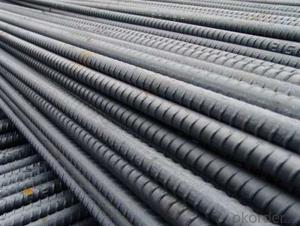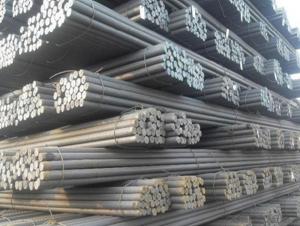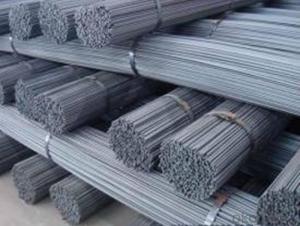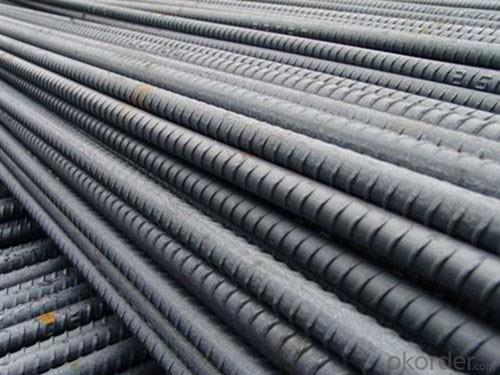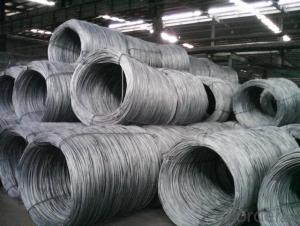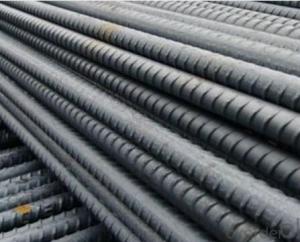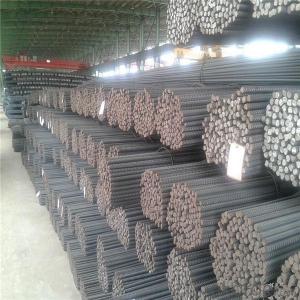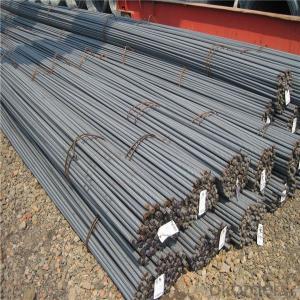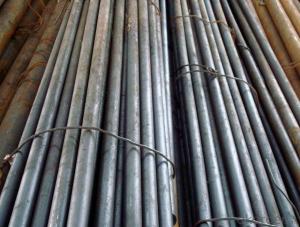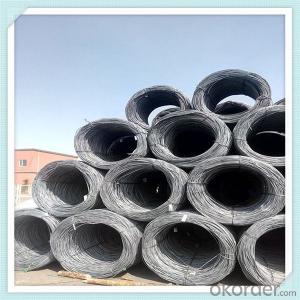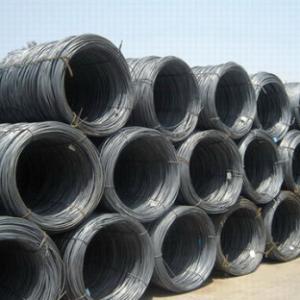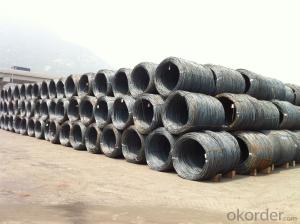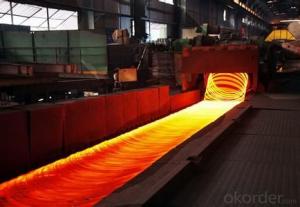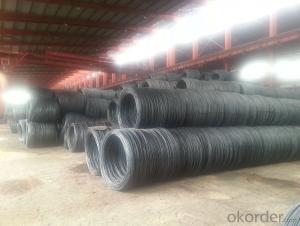Prime Hot Rolled Reinforcement Steel Rebar / Iron Rods
- Loading Port:
- Tianjin
- Payment Terms:
- TT OR LC
- Min Order Qty:
- 500 m.t.
- Supply Capability:
- 1000000 m.t./month
OKorder Service Pledge
OKorder Financial Service
You Might Also Like
1. Introduction:
.commodity:steel wire rod
.grade:Q195,SAE1008B-SAE1018B
.diameter:5.5mm-14mm
.type:in coil
.coil weight:around 2 mt
2. Specifications:
| Products | hot rolled steel rebar |
| 1.Standards | GB/BS/ASTM/DIN/JIS |
| 2.Grade | HRB335,HRB400,HRB500,G460B,B500A-C/BST500S/SD390/400 |
| 3.Diamter | 6,8,10,12,14,16,18,20,22,25,28,32,36mm |
| 4.MOQ | 20 tons each size |
| 5.Application | framework of reinforced concrete building component civil engineering construction,like house,bridge,road,etc |
| 6.Payment | T/T, L/C |
| 7.Delivery | 20-40 days |
| 8.Advantages | full size, competitive price and quality |
3.Application:
Applicationwidely used in machinery parts, manufacturing industry, electronics industry, metal tools and others
4. Pictures
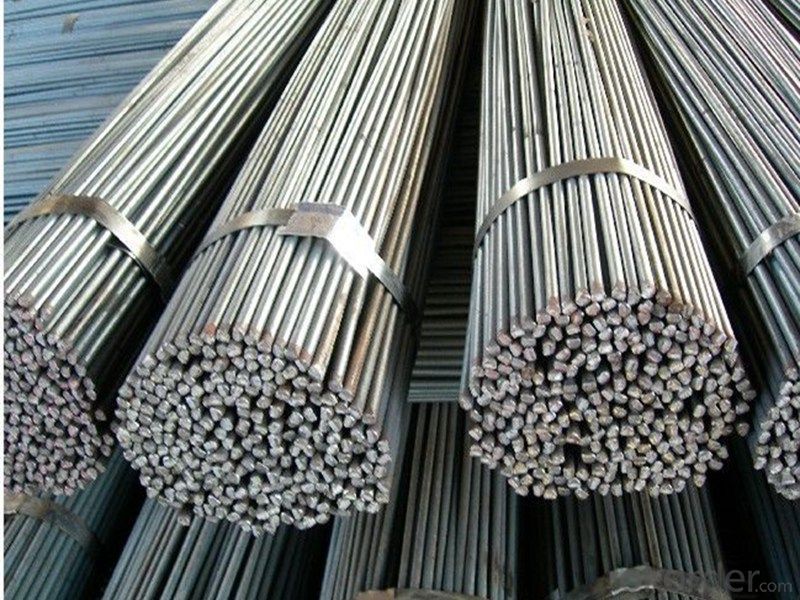
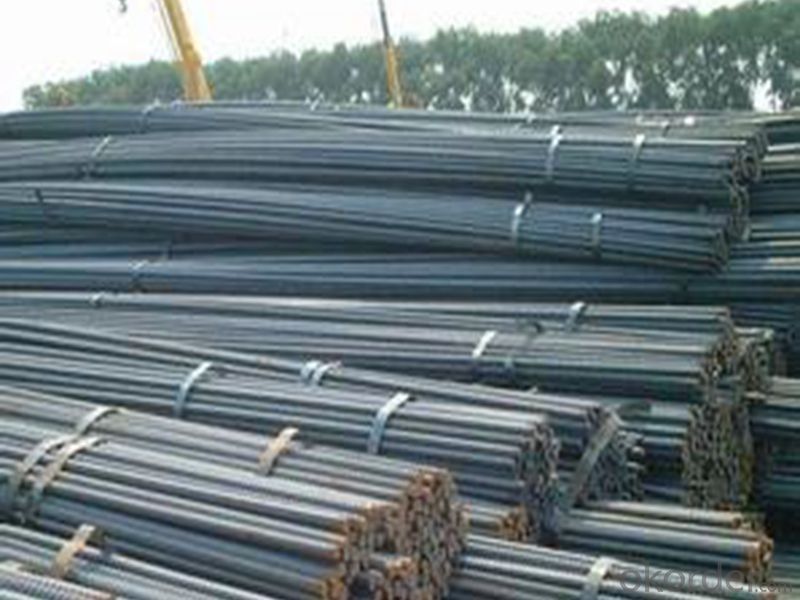
5.FAQ
We have organized several common questions for our clients,may help you sincerely:
①How about your company?
A world class manufacturer & supplier of castings forging in carbon steel and alloy steel,is one of the large-scale professional investment casting production bases in China,consisting of both casting foundry forging and machining factory. Annually more than 8000 tons Precision casting and forging parts are exported to markets in Europe,America and Japan. OEM casting and forging service available according to customer’s requirement.
②How to guarantee the quality of the products?
We have established the international advanced quality management system,every link from raw material to final product we have strict quality test;
- Q: How is steel wire rod used in the manufacturing of wire forms for fishing nets?
- Steel wire rod is used in the manufacturing of wire forms for fishing nets as it serves as the primary material for creating the core structure of the nets. The wire rod is typically shaped and twisted into specific designs to form the framework and support system of the fishing net. Its strong and durable properties make it ideal for withstanding the tension and pressure exerted by water currents and the weight of captured fish, ensuring the longevity and effectiveness of the fishing net.
- Q: How is steel wire rod used in the production of wire screens?
- Steel wire rod is used in the production of wire screens as it serves as the primary material for creating the screen mesh. The wire rod is drawn through a series of dies to achieve the desired diameter and strength. This process results in a long, continuous piece of wire that can be woven or welded to create the wire mesh for screens. The steel wire rod's durability and flexibility make it an ideal choice for wire screens, ensuring a strong and reliable product for various applications such as filtration, separation, and protection.
- Q: How are steel wire rods used in the production of screws and bolts for construction projects?
- Steel wire rods are used in the production of screws and bolts for construction projects as they serve as the raw material for manufacturing these fasteners. The wire rods are first heated and then rolled into the desired diameter and length, which are then cut and threaded to form screws and bolts. These high-strength steel wire rods ensure the durability and structural integrity of the fasteners, making them suitable for various construction applications.
- Q: What are the potential drawbacks of using steel wire rod?
- There are several potential drawbacks of using steel wire rod. Firstly, steel wire rod is susceptible to corrosion and rusting when exposed to moisture or certain environmental conditions. This can lead to degradation of the material over time, reducing its strength and structural integrity. Secondly, steel wire rod can be relatively heavy compared to other materials, which can be a disadvantage in certain applications where weight is a concern. This can make transportation and handling of steel wire rod more challenging and expensive. Additionally, steel wire rod may have limited flexibility compared to other materials. This can be a disadvantage in situations where the wire needs to be bent or shaped into complex forms or tight spaces. Furthermore, steel wire rod can be more expensive compared to alternative materials, which can impact the overall cost of a project. The cost of production, transportation, and installation of steel wire rod can be higher, making it a less economical choice in some cases. Lastly, steel wire rod may have limitations in terms of its electrical conductivity or magnetic properties, which can be a drawback in applications where these properties are critical. Overall, while steel wire rod offers numerous advantages such as high strength and durability, it is important to consider these potential drawbacks before choosing it for a specific application.
- Q: How are steel wire rods used in the production of wire springs for mechanical devices?
- Steel wire rods are an essential component in the production of wire springs for mechanical devices. These wire rods are made of high-quality steel that possesses excellent strength and elasticity properties. To begin, the steel wire rods are first processed through a series of manufacturing steps. This includes cleaning the rods to remove any impurities and then heating them to a specific temperature to make them more malleable. Once heated, the rods are passed through a series of rollers, which gradually reduce their diameter to the desired size. This process, known as wire drawing, ensures that the steel wire rods are of the correct thickness for the production of wire springs. After the wire drawing process, the steel wire rods are further treated to enhance their properties. This may involve heat treatment processes such as annealing or quenching, which can increase the strength and elasticity of the wire. Additionally, the rods may also undergo surface treatments such as electroplating or coating to improve their corrosion resistance. Once the steel wire rods are prepared, they are then used to manufacture wire springs for mechanical devices. Wire springs are widely used in various applications, ranging from automotive suspension systems to household appliances. The wire rods are fed into specialized machinery, where they are coiled or bent to form the desired shape of the spring. The machinery applies tension and pressure to the wire rods, causing them to deform and take on the spring shape. The quality and properties of the steel wire rods play a crucial role in determining the performance and durability of the resulting wire spring. In summary, steel wire rods are essential raw materials in the production of wire springs for mechanical devices. They undergo various manufacturing processes to ensure the desired strength, elasticity, and corrosion resistance. Once prepared, the wire rods are used in specialized machinery to form wire springs, which are critical components in a wide range of mechanical devices.
- Q: What are the different types of steel wire rod coatings used for increased adhesion?
- To enhance adhesion, various types of coatings are commonly applied to steel wire rods. These coatings serve to improve the wire rod's ability to bond with other materials. Among the commonly used coatings is zinc coating, also referred to as galvanizing. This process involves immersing the wire rod in molten zinc, creating a protective layer on the steel surface. Zinc coating not only enhances adhesion but also provides corrosion resistance, making it suitable for outdoor use. Another popular coating is copper coating, achieved through electroplating the wire rod with a layer of copper. This coating enhances adhesion and improves conductivity, making it ideal for electrical applications that require a strong and reliable bond. For increased adhesion, phosphate coating is another option. This method involves treating the wire rod with a solution containing phosphoric acid and other chemicals, resulting in a thin layer of phosphate crystals on the surface. The roughened surface created by the phosphate coating improves adhesion by promoting better bonding. In certain applications, polymer coating is utilized to enhance adhesion. This process involves applying a layer of polymer material, such as polyethylene or polyvinyl chloride (PVC), to the wire rod. Polymer coatings not only provide a strong bond with other materials but may also offer additional benefits such as insulation or protection against chemicals. In conclusion, zinc coating, copper coating, phosphate coating, and polymer coating are different types of steel wire rod coatings used to enhance adhesion. Each coating possesses unique properties and is suitable for specific applications where improved adhesion is required.
- Q: What are the different surface defects that can affect the ductility of steel wire rod?
- Some of the different surface defects that can affect the ductility of steel wire rod include cracks, surface roughness, scale, pitting, and surface decarburization. These defects can weaken the material and reduce its ability to stretch or deform without breaking.
- Q: What are the major risks and uncertainties in the steel wire rod industry?
- The major risks and uncertainties in the steel wire rod industry include fluctuations in raw material prices, such as iron ore and scrap metal, which can impact production costs and profitability. Market demand and competition can also pose risks, as changes in consumer preferences or economic conditions can affect the demand for steel wire rods. Additionally, regulatory changes and environmental concerns surrounding the industry's carbon emissions and sustainability practices can introduce uncertainties. Technological advancements and automation may also impact the industry, requiring companies to adapt and invest in new equipment and processes to remain competitive.
- Q: How is steel wire rod used in the production of reinforcement bars?
- Steel wire rod is used in the production of reinforcement bars by being heated and then rolled into the desired shape and size. This process, known as hot rolling, helps increase the strength and durability of the reinforcement bars. The steel wire rod acts as the core material, providing the necessary tensile strength to the reinforcement bars, which are primarily used to reinforce concrete structures such as buildings, bridges, and highways.
- Q: How is steel wire rod used in the production of wire mesh for acoustic panels?
- Steel wire rod is used in the production of wire mesh for acoustic panels as it serves as the primary material for creating the mesh structure. The wire rod is typically drawn through a series of dies to obtain the desired diameter and then woven or welded together to form the wire mesh. This mesh provides the necessary support and stability to the acoustic panels, allowing sound waves to pass through while reducing noise and enhancing sound absorption.
Send your message to us
Prime Hot Rolled Reinforcement Steel Rebar / Iron Rods
- Loading Port:
- Tianjin
- Payment Terms:
- TT OR LC
- Min Order Qty:
- 500 m.t.
- Supply Capability:
- 1000000 m.t./month
OKorder Service Pledge
OKorder Financial Service
Similar products
Hot products
Hot Searches
Related keywords
